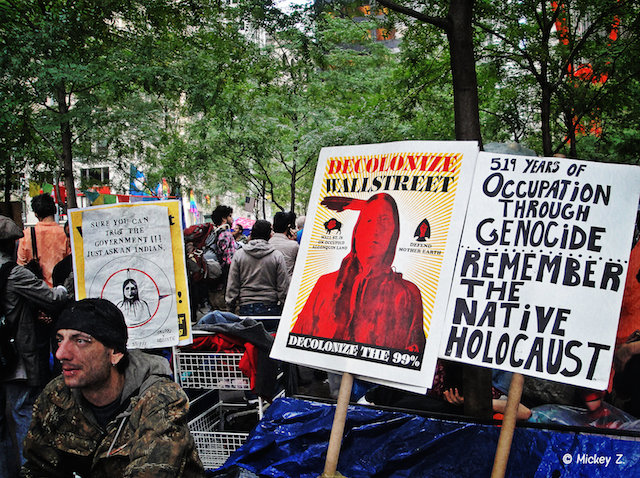The Seminole-African Alliance
By Mickey Z.
27 July , 2014
World News Trust

Photo credit: Mickey Z.
“We're gonna fight racism with solidarity.” - Fred Hampton
The Native American Indian people that comprised the Seminole Nation grew out of the Creek Nation in Florida. Multilingual and diverse, the Seminoles (from a word meaning “runaway”) became infamous for intermingling with runaway slaves from Georgia and the Carolinas… slaves that built prosperous, free, self-governing communities since 1738.
Historian William Loren Katz explains explains the genesis of this alliance: “Africans began to instruct Seminoles in methods of rice cultivation they had learned in Senegambia and Sierra Leone. Then the two peoples forged an agricultural and military alliance that challenged slave-hunters and then U.S. troops. Some African families lived in separate villages, others married Seminoles, and the two peoples with a common foe shaped joint diplomatic and military initiatives. Africans, with the most to lose, rose to Seminole leadership as warriors, interpreters, and military advisors.”
“The two races, the negro and the Indian, are rapidly approximating; they are identical in interests and feelings,” said U.S. Major General Sidney Thomas Jesup, at the time. “Should the Indians remain in this territory the negroes among them will form a rallying point for runaway negroes from the adjacent states; and if they remove, the fastness of the country will be immediately occupied by negroes.”
The first foreign invasion launched by the fledgling U.S. government was the 1816 assault on the Seminole Nation -- an assault met with fierce resistance. After Spain sold Florida to the U.S. in 1819, America’s full military might was put to work reclaiming the land from both former slaves and their indigenous co-inhabitants.
In a scenario that would presage future U.S. interventions in places like the Philippines, Vietnam, Iraq, and beyond, roughly 4,000 black and Indian fighters effectively utilized hit-and-run guerrilla tactics against more than 200,000 U.S. Army troops.
The U.S. military response to such tactics should also sound familiar: Besides futile attempts to racially divide the Seminole Nation, soldiers violated agreements, destroyed crops, cattle and horses, and seized women and children as hostages.
Although the sheer numbers would eventually bring defeat to the brave Red and Black Seminoles, the resistance of Christmas Eve 1837 remains a powerful example of the cunning forces of right prevailing over the arrogant power of might.
"An estimated 380 to 480 freedom-fighting African and Indian members of the Seminole nation threw back an advance of more than a thousand U.S. Army and other troops led by Colonel Zachary Taylor, a future president of the United States,” explains Katz. “The Seminoles so badly mauled the invaders that Taylor ordered his soldiers to fall back, bury their dead, tend to their wounded and ponder the largest single U.S. defeat in decades of Indian warfare. The battle of Lake Okeechobee is not a story you will find in school or college textbooks, and has slipped from the public consciousness. But in a country that cherishes its freedom-fighting heritage, Black and Red Seminoles of Florida sent everyone a message that deserves to be remembered and honored.”
Part of that message is the urgent need for deeper solidarity and broader coalitions within the struggle for justice. As activists, we must rediscover our history. We must never forget those whose shoulders we stand upon. We must recognize that there’s a lot more to our revolutionary heritage than rich and/or charismatic white “leaders.” We must embrace collective efforts towards collective liberation.
#shifthappens
***
Mickey Z. is the author of 12 books, most recently Occupy this Book: Mickey Z. on Activism. Until the laws are changed or the power runs out, he can be found on a couple of obscure websites called Facebook and Twitter. Anyone wishing to support his activist efforts can do so by making a donation here.
©WorldNewsTrust.com
Comments are moderated
